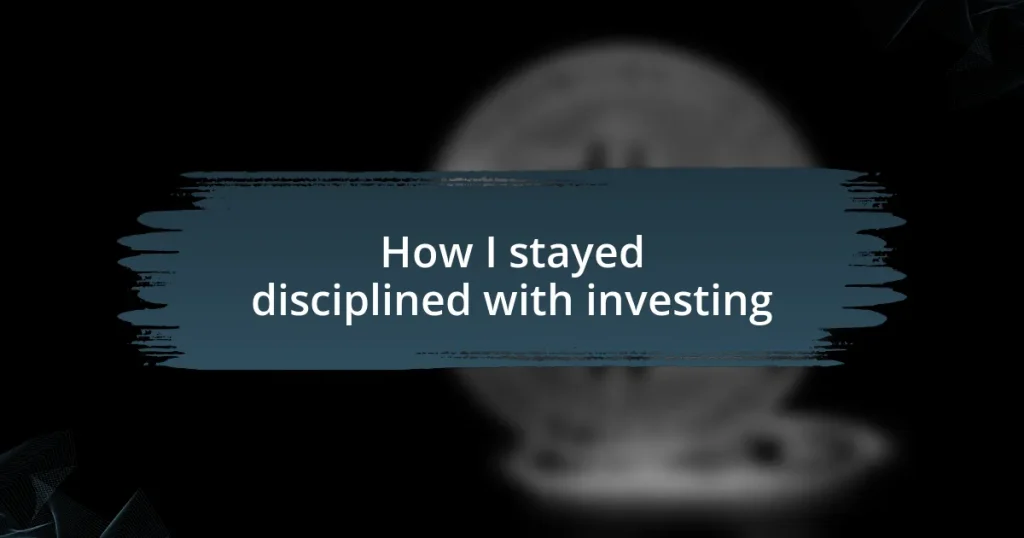Key takeaways:
- Investment discipline involves maintaining focus on long-term goals amid market volatility, preventing impulsive decisions.
- Setting clear financial goals provides direction, while a structured investment plan minimizes emotional reactions to market changes.
- Regular monitoring and thoughtful adjustments to investments align strategies with long-term objectives and foster resilience.
- Learning from mistakes, such as researching before investing and not holding onto losing stocks, is essential for growth in investing.
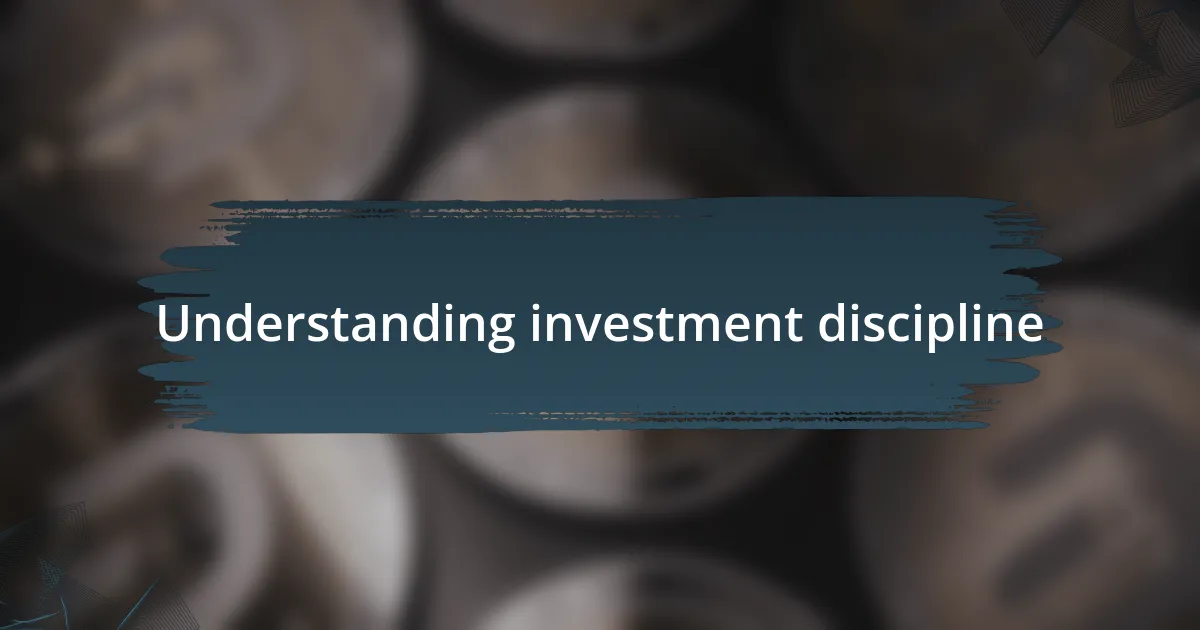
Understanding investment discipline
Investment discipline is about maintaining focus and consistency, even when market conditions become turbulent. I remember the first time I faced a market dip; I felt a wave of anxiety wash over me. It was a real test of my commitment to my investment strategy. How could I stay the course when everything seemed to be going wrong?
Staying disciplined requires an understanding of both your goals and the underlying reasons for your investment choices. I often remind myself of the long-term vision I set for my portfolio. It helps to ask myself, “Will this short-term fluctuation matter in five years?” Keeping that perspective has been crucial for me in avoiding impulsive decisions driven by fear or excitement.
Moreover, creating a structured plan can serve as a lifeline during chaotic times. I’ve developed a checklist of my investment principles; it acts as a compass that guides me back to rationality whenever I’m tempted to stray. This approach has not only enhanced my confidence but also reinforced my commitment to disciplined investing. What strategies have you found helpful to stay grounded during market swings?
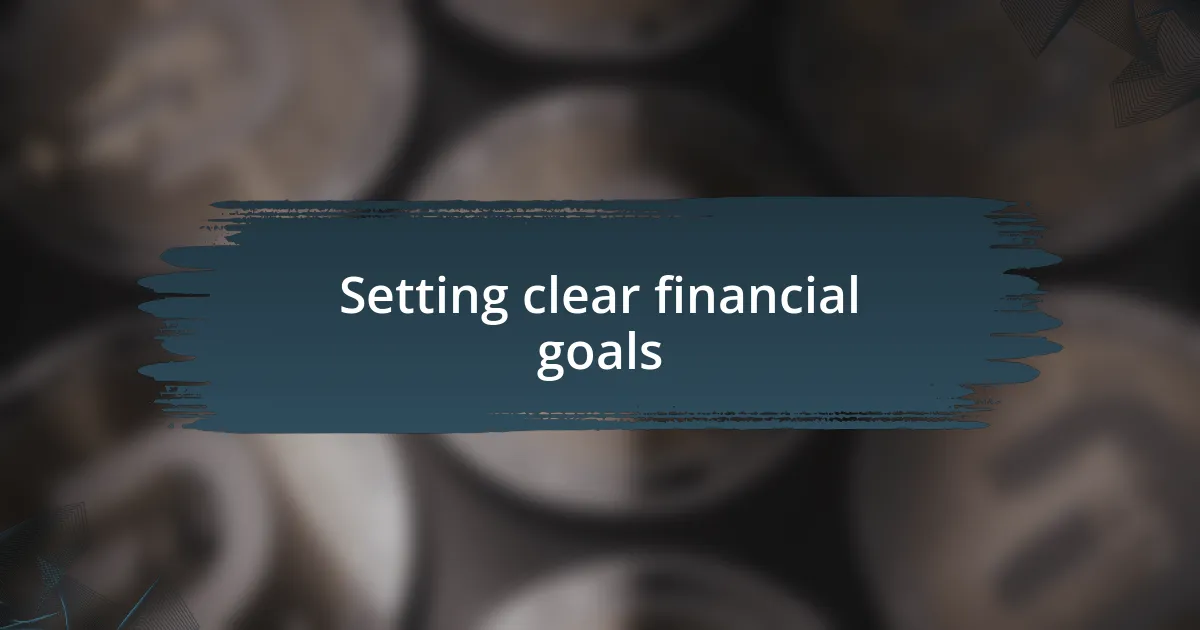
Setting clear financial goals
Setting clear financial goals is essential for any investor, as it provides direction and purpose for your investment decisions. When I first started investing, I vividly remember setting a goal to save for my children’s education. This clear objective helped me navigate through uncertain markets without losing sight of what truly mattered. It became much easier to bear short-term volatility when I kept envisioning the long-term outcomes tied to those goals.
To help you craft your own financial goals, consider these key points:
- Define Your Objectives: Be specific about what you’re investing for; whether it’s retirement, a home, or education, clarity is vital.
- Set a Timeline: Establish a timeframe for achieving your goals. This urgency can motivate you to stay disciplined.
- Quantify Your Goals: Determine how much you need to save or invest to reach your objectives, allowing you to track your progress.
- Prioritize: Decide which goals are most important to you. This helps in allocating resources efficiently and avoiding distractions.
- Review Regularly: Evaluate your goals periodically and adjust them as needed to stay on track.
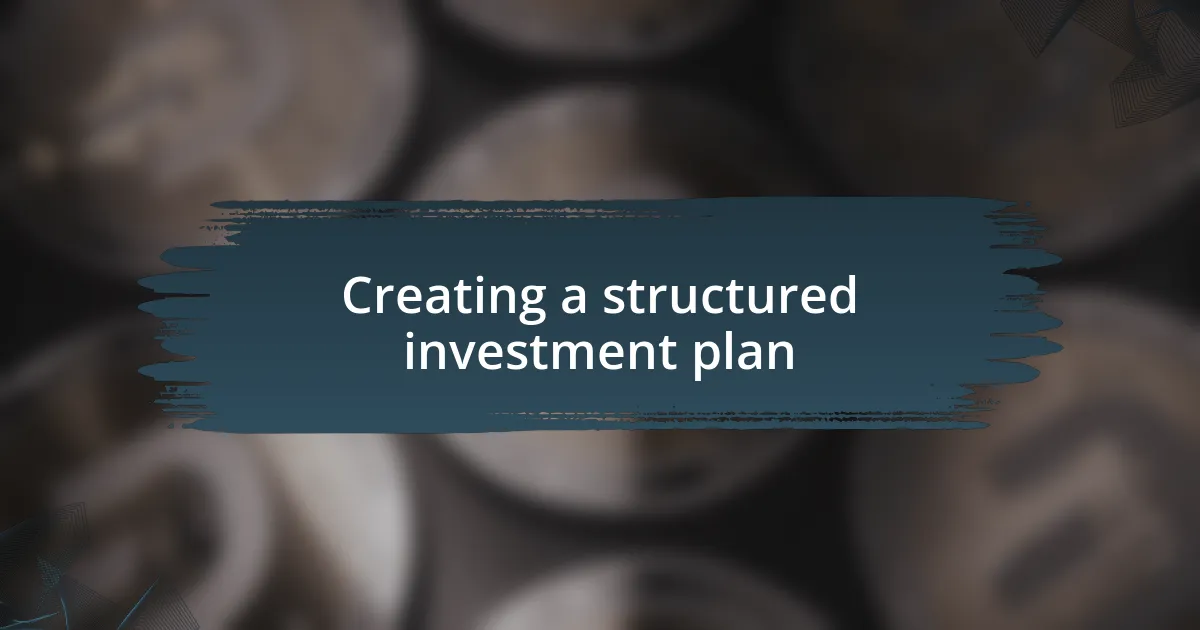
Creating a structured investment plan
Creating a structured investment plan is pivotal to achieving your financial goals. When I first devised my investment strategy, I focused on developing a clear roadmap that would guide my decisions. This plan encompassed asset allocation, risk tolerance, and a schedule for regular contributions. By having a structured approach, I found that it minimized emotional reactions to market shifts, allowing me to stick to my long-term vision.
In my early days, I learned the importance of regularly revisiting and tweaking my investment plan. Just like any project, the unexpected can arise, and being flexible is key. For instance, when the market took an unexpected downturn, I was able to re-evaluate my asset allocation. Seeing how my investments were performing in light of my goals helped me stay focused and motivated.
Here’s how I structured my investment plan in comparison to a more unstructured approach:
| Structured Investment Plan | Unstructured Investment Approach |
|---|---|
| Clearly defined goals | Vague objectives |
| Regular contributions | Inconsistent investing |
| Periodic reviews | Rare evaluations |
| Asset allocation strategy | No clear strategy |
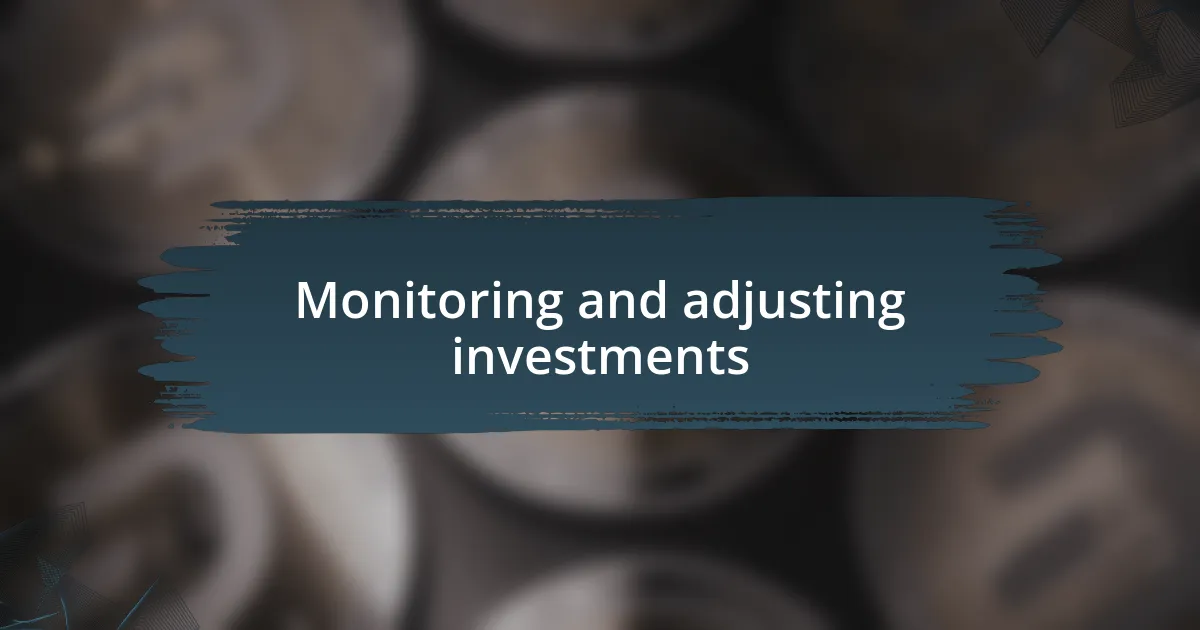
Monitoring and adjusting investments
Monitoring your investments is crucial for staying on track with your financial goals. I remember a time when I thought simply investing was enough—how naive! It wasn’t until I started regularly tracking my portfolio that I realized how essential it was to stay informed. Changes in the market can dramatically affect the performance of your assets, so I took it upon myself to check in on my investments at least once a month.
Adjusting investments is not just a reactive measure; it’s an active one. There was one moment where one of my stocks soared unexpectedly. Initially, I felt a rush of excitement, but it quickly turned into a concern. Should I sell and take the profits or hold on for even more growth? In that instance, I decided to assess my overall investment strategy against my long-term goals. By being disciplined and not letting emotion dictate my decisions, I made an adjustment that ultimately worked in my favor.
One valuable lesson I’ve learned is to ask myself, “What do these numbers mean for my future?” This kind of reflective thinking helped refine my investment approach over the years. There have been instances when I had to let go of an underperforming asset. It was tough, but by understanding the bigger picture, I was able to make changes that better aligned with my investment objectives. Ultimately, continual monitoring and thoughtful adjustments have become part of my investment journey, allowing me to remain disciplined and focused on my long-term financial aspirations.
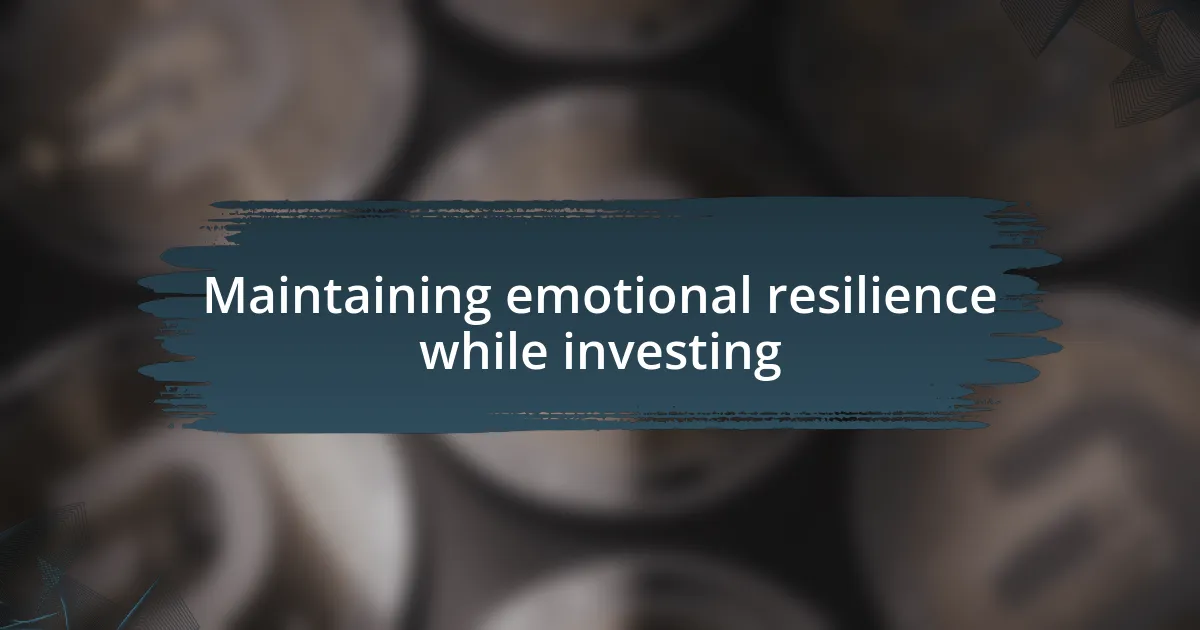
Maintaining emotional resilience while investing
Maintaining emotional resilience while investing is essential, and I can attest to that through my own experiences. There was a particularly turbulent market phase where panic seemed to grip everyone around me. I remember feeling a knot in my stomach as stock prices plummeted. In that moment, I took a deep breath and reminded myself of my long-term vision. It helped me see that short-term volatility is just part of the investing landscape.
I’ve also learned the importance of detaching my self-worth from my investment choices. When I faced a significant loss in one of my holdings, I initially felt like a failure. I had to repeatedly tell myself that each investment decision doesn’t define my intelligence or value. Instead, I started viewing setbacks as learning opportunities, which helped me bounce back with renewed focus and confidence.
One effective strategy I adopted is maintaining a journal of my investment thoughts and feelings. This practice allows me to track not just my financial decisions but also my emotional responses. Reflecting on these experiences helps me see patterns in my reactions. By analyzing how I felt during high and low points, I become more aware of my emotional triggers and can approach future investments with a clearer perspective. Does anyone else find that writing about their feelings helps clarify their thoughts? I certainly do!
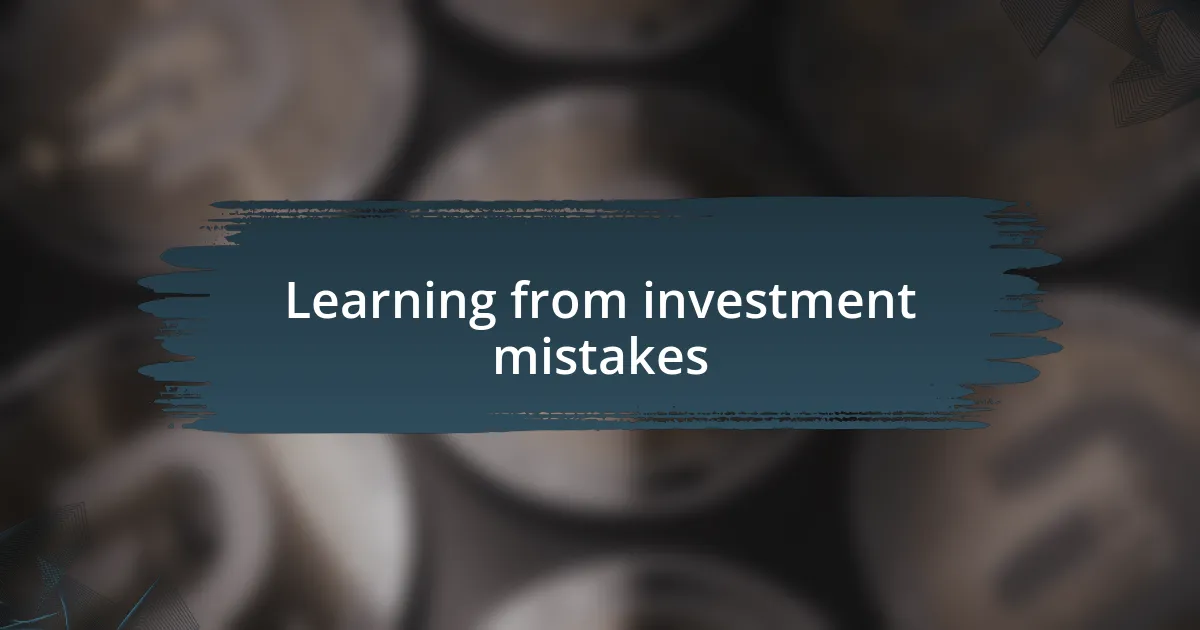
Learning from investment mistakes
Recognizing my investment mistakes has been a pivotal learning experience. I vividly remember a time when I jumped into a stock purely based on hype without doing thorough research. The aftermath was painful as the stock tanked, teaching me that due diligence isn’t just a checklist—it’s a must. Have you ever realized that a little research could have saved you from a costly error? I certainly have.
My biggest mistake involved holding on to a losing investment for far too long, hoping it would recover. It was like watching a sinking ship while clutching my life vest tightly. The lesson here was clear: sometimes, I need to cut my losses and move on. Don’t get too attached—investing is not an emotional endeavor, or at least it shouldn’t be. Can you relate? It took me time to understand that it’s okay to let go for the sake of better opportunities.
Additionally, I’ve made it a habit to review my investment decisions regularly. This reflection process often reveals patterns in my decision-making that might slip by unnoticed. For instance, I’ve spotted moments when fear drove me to sell prematurely. I wonder how many others overlook these critical learnings. Sharing these reflections not only strengthens my strategy but also adds an emotional layer of growth that can be incredibly empowering.
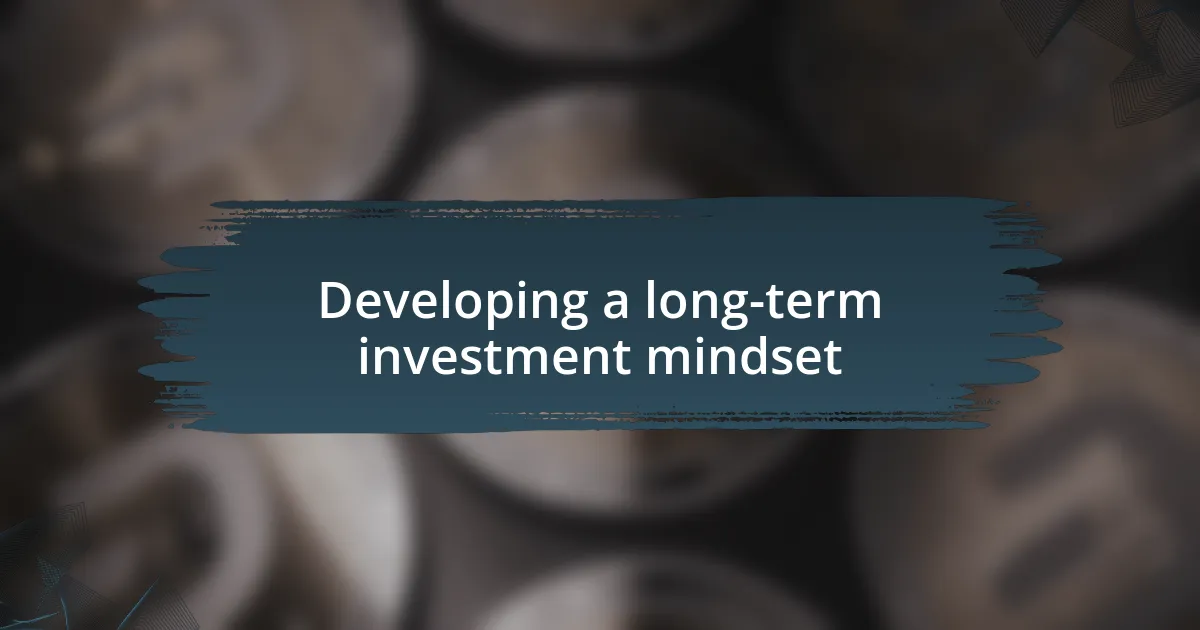
Developing a long-term investment mindset
Cultivating a long-term investment mindset requires patience and a willingness to weather the ups and downs of the market. I remember my early days of investing when I was easily swayed by daily price fluctuations. Each minor dip felt like a personal defeat, leaving me anxious and second-guessing my choices. It was a wake-up call for me to realize that true investing isn’t about chasing quick gains; it’s about nurturing my investments over time. Have you ever felt that urge to act impulsively? I have, but learning to resist that impulse has been a game changer.
My perspective shifted when I started viewing investments as part of a larger journey rather than a series of isolated transactions. I recall vividly making a commitment to hold a well-performing stock despite market volatility. Staying true to that commitment during downturns gave me immense satisfaction and taught me the value of resilience. This mindset made me appreciate that each investment contributes to a bigger picture. How often do you think about the long-term trajectory of your investments?
Embracing a long-term outlook also helped me set clear goals that align with my personal values. I’ve often visualized my financial future, which allowed me to see investing as a means to create the life I desire rather than merely a way to accumulate wealth. It’s fascinating how that shift in focus can shift the emotional landscape of investing. Do you see investing as a pathway toward your dreams? Understanding your ‘why’ can be a powerful motivator in maintaining that discipline.











